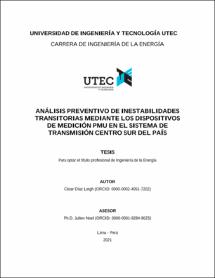| dc.contributor.advisor | Noel, Julien Georges Andre | |
| dc.contributor.author | Díaz Leigh, César | |
| dc.date.accessioned | 2021-12-13T07:05:22Z | |
| dc.date.available | 2021-12-13T07:05:22Z | |
| dc.date.issued | 2021 | |
| dc.identifier.citation | Díaz Leigh, C. (2021). Análisis preventivo de inestabilidades transitorias mediante los dispositivos de medición PMU en el sistema de transmisión centro sur del país [Tesis de Título Profesional, Universidad de Ingeniería y Tecnología]. Repositorio Institucional UTEC. http://repositorio.utec.edu.pe/handle/20.500.12815/253 | es_PE |
| dc.identifier.uri | https://hdl.handle.net/20.500.12815/253 | |
| dc.description.abstract | La presente tesis abarca la implementación de una metodología de detección de fallas por inestabilidad transitoria en el Sistema de Transmisión Centro Sur del país. Para ello, se seleccionaron tres casos de estudio considerando un tiempo de reposición mayor al promedio (190 ms), una potencia interrumpida mayor a 32 MW y el tipo de línea según su tensión (500 kV). El primer caso analizado fue la desconexión de la línea 5032 (ChilcaPoroma), que tuvo un tiempo de reposición de 5h 49 min y una potencia interrumpida de 195.17 MW. Aplicando la metodología de detección, se obtuvo un ángulo crítico de 0.932 rad y un ahorro de tiempo de 1.41s respecto al valor angular de referencia que propone el estudio de operatividad (3.1416 rad), en el que se observa el inicio de un proceso de inestabilidad transitoria.
El segundo caso analizado fue la desconexión de la línea 5011 (Chilca NuevaFénix), que tuvo un tiempo de reposición de 4h 14 min y una potencia interrumpida de 529.6 MW; obteniendo un ángulo crítico de 1.26 rad y un ahorro de tiempo de 4.75 s. Por último, el tercer caso analizado fue la desconexión de la línea 5034 (Poroma-Ocoña), que tuvo un tiempo de reposición de 1h 30 min y una potencia interrumpida de 332 MW; obteniendo un ángulo crítico de 1.22 rad y un ahorro de tiempo de 6.4 s.
Realizado este análisis, se pudo concluir que la aplicación de la metodología de detección tuvo éxito, dado que permitió un ahorro de tiempo frente al valor referencial de inicio de inestabilidad, lo que ayudaría a reducir el tiempo que le tomaría a una línea de transmisión el reinsertarse al SEIN. | es_PE |
| dc.description.abstract | This thesis covers the implementation of a methodology for detecting transient instability failures in the Center-South Transmission System of Peru. For this, three case studies were selected considering a replacement time greater than the average (190 ms), an interrupted power greater than 32 MW and the type of line according to its voltage (500 kV). The first case analyzed was the disconnection of line 5032 (Chilca-Poroma), which had a replacement time of 5h 49 min and an interrupted power of 195.17 MW. Applying the detection methodology, an angle of critical phasor of 0.932 rad was obtained and a time saving of 1.41s with respect to the reference phasor value proposed by the operability study (3.1416 rad), in which the beginning of a process of transient instability.
The second case analyzed was the disconnection of line 5011 (Chilca Nueva-Fénix), which had a replacement time of 4h 14 min and an interrupted power of 529.6 MW; obtaining an angle of critical phasor of 1.26 rad and a time saving of 4.75 s.
Finally, the third case analyzed was the disconnection of line 5034 (Poroma-Ocoña), which had a replacement time of 1h 30 min and an interrupted power of 332 MW; obtaining an angle of critical phasor of 1.22 rad and a time saving of 6.4 s. Once this analysis was carried out, it can be concluded that the application of the detection methodology was successful, since it allowed a saving of time compared to the initial instability reference value, which would help reduce the time that it would take for a transmission line to reinsert to the SEIN. | es_PE |
| dc.description.uri | Tesis | es_PE |
| dc.format | application/pdf | es_PE |
| dc.language.iso | spa | es_PE |
| dc.publisher | Universidad de Ingeniería y Tecnología | es_PE |
| dc.rights | info:eu-repo/semantics/openAccess | es_PE |
| dc.rights.uri | http://creativecommons.org/licenses/by-nc-nd/4.0/ | |
| dc.source | Repositorio Institucional UTEC | es_PE |
| dc.source | Universidad de Ingeniería y Tecnología - UTEC | es_PE |
| dc.subject | Metodología | es_PE |
| dc.subject | Simulaciones | es_PE |
| dc.subject | Inestabilidad | es_PE |
| dc.subject | Sistema de transmisión | es_PE |
| dc.subject | Sistema Eléctrico Interconectado Nacional (SEIN) | es_PE |
| dc.subject | Simulaciones de estabilidad transitoria | es_PE |
| dc.subject | Estabilidad transitoria | es_PE |
| dc.title | Análisis preventivo de inestabilidades transitorias mediante los dispositivos de medición PMU en el sistema de transmisión centro sur del país | es_PE |
| dc.title.alternative | Corrective analysis of transient instabilities for PMU protection devices in the centersouth transmission system of Peru | es_PE |
| dc.type | info:eu-repo/semantics/bachelorThesis | es_PE |
| dc.subject.ocde | https://purl.org/pe-repo/ocde/ford#2.07.03 | es_PE |
| dc.publisher.country | PE | es_PE |
| thesis.degree.discipline | Ingeniería de la Energía | es_PE |
| thesis.degree.grantor | Universidad de Ingeniería y Tecnología. Ingeniería de la Energía | es_PE |
| thesis.degree.level | Título Profesional | es_PE |
| thesis.degree.name | Ingeniero de la Energía | es_PE |
| renati.advisor.dni | 48506956 | |
| renati.advisor.orcid | https://orcid.org/ 0000-0001-9284-9025 | es_PE |
| renati.author.dni | 76605839 | |
| renati.author.orcid | https://orcid.org/ 0000-0002-4051-7202 | es_PE |
| renati.discipline | 711026 | es_PE |
| renati.juror | Ramirez Quiroz, Elmer Hernan | |
| renati.juror | Ramos Saravia, José César | |
| renati.juror | Vera Pomalaza, Rafael | |
| renati.level | http://purl.org/pe-repo/renati/level#tituloProfesional | es_PE |
| renati.type | http://purl.org/pe-repo/renati/type#tesis | es_PE |


